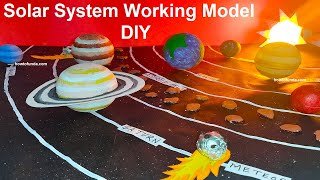In this video we show you how to make the solar system working model – simple – easy – innovative inspire award – science exhibition
Solar System Introduction
The solar system is a vast celestial system that consists of the Sun, planets, their moons, asteroids, comets, and other celestial objects, all bound together by gravity.
It’s a dynamic and complex system that orbits around the Sun, and it is located within the Milky Way galaxy.

Key elements of the solar system include:
- The Sun: The Sun is a massive, hot, and luminous star at the center of the solar system. It provides light, heat, and energy to all the planets and celestial bodies within its gravitational influence.
- Planets: There are eight recognized planets in the solar system, listed in order of their distance from the Sun: Mercury, Venus, Earth, Mars, Jupiter, Saturn, Uranus, and Neptune. Each planet has its own unique characteristics, including size, composition, and atmosphere.
- Moons: Many of the planets have natural satellites or moons that orbit around them. Earth’s moon is the most well-known, but other planets like Jupiter and Saturn have a substantial number of moons.
- Asteroids and Comets: These are smaller celestial bodies that orbit the Sun. Asteroids are rocky or metallic, while comets are made up of ice, dust, and rocky material. They can be found in various parts of the solar system, including the asteroid belt between Mars and Jupiter.
- Dwarf Planets: In addition to the eight recognized planets, there are also several dwarf planets in the solar system, including Pluto, Eris, Haumea, Makemake, and Ceres.
- Orbital Paths: The planets in the solar system follow elliptical paths around the Sun, known as orbits. These orbits are determined by the gravitational pull of the Sun.
How To Make Solar system Working Model
Creating a solar system working model using thermocol balls is an excellent way to learn about the planets in our solar system and their relative sizes and positions. Here’s a step-by-step guide to making a basic solar system model using thermocol balls:
Materials you will need:
- Large thermocol ball (representing the Sun)
- Smaller thermocol balls (representing the planets)
- Cardboard
- Acrylic paints or markers
- Paintbrushes (if using acrylic paints)
- String or fishing line
- Glue
- Scissors
Step-by-step Video instructions:
- Paint the thermocol balls:
- Start by painting the large thermocol ball yellow or orange to represent the Sun. You can use acrylic paints or markers for this.
- Paint the smaller thermocol balls to represent each planet in different colors. Here are the colors commonly associated with each planet:
- Mercury: Grey
- Venus: Yellowish-white
- Earth: Blue and green (for land and oceans)
- Mars: Red
- Jupiter: Orange and white stripes
- Saturn: Light yellow with a thin brown band (to represent its rings)
- Uranus: Light blue
- Neptune: Dark blue
- Arrange the planets on cardboard:
- Now, determine the order of the planets in our solar system and their relative distances from the Sun.
- Arrange the planets in a line, starting with Mercury closest to the Sun and moving outward to Neptune.
- Use the strings or fishing line to hang the planets at different heights, ensuring they are spaced according to their relative distances from the Sun.
- Create a display base:
- Cut a piece of thermocol or cardboard to use as the base for your solar system model.
- Glue the Sun (large thermocol ball) to the center of the base.
- Add labels and details:
- Using a marker or a small piece of paper, label each planet with its name.
#solarsystem #workingmodel #scienceproject #scienceexhibition #sciencefair #howtofunda #inspireaward #inspireawardproject

